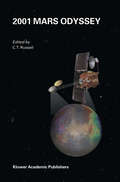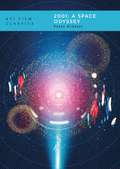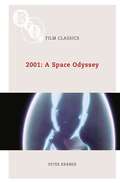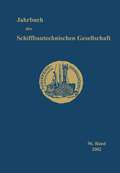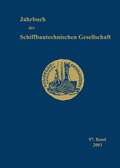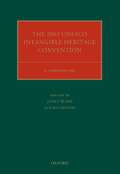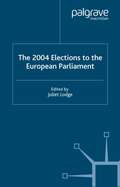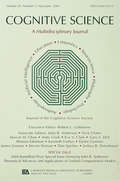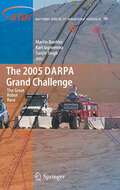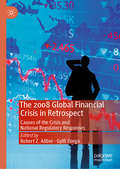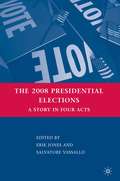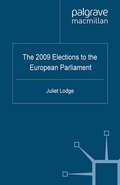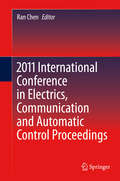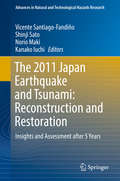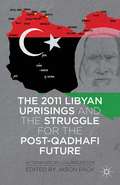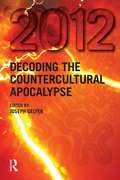- Table View
- List View
2001 Mars Odyssey
by C. T. RussellMars, the most habitable of our sister planets, holds a special place in our imaginations and in our space exploration program. Fully half of NASA's planetary exploration effort is now devoted to Mars. Key questions include: Has Mars ever harbored life? Is there life on Mars now? Will humans be able to survive on the Martian surface? Answers to these questions lie in determining the present location of water on Mars and its likely inventory in the past, and in determining the present radiation environment of Mars. The 2001 Mars Odyssey Mission contributes greatly these answers by detecting near-surface water through measurements of neutron flux, from the detection of carbonates, and the quantification of its radiation environment. This book captures the objectives, the design of the mission and the details of the instruments carried to Mars. It should be of interest to every scientist interested in participating in the on-going exploration of Mars from graduate students to senior scientists as it provides the background information essential to interpret the many exciting results now appearing from the mission.
2001: A Space Odyssey (BFI Film Classics)
by Peter KrämerStanley Kubrick's 2001: A Space Odyssey (1968) is widely regarded as one of the best films ever made. It has been celebrated for its beauty and mystery, its realistic depiction of space travel and dazzling display of visual effects, the breathtaking scope of its story, which reaches across millions of years, and the thought-provoking depth of its meditation on evolution, technology and humanity's encounters with the unknown. 2001 has been described as the most expensive avant-garde movie ever made and as a psychedelic trip, a unique expression of the spirit of the 1960s and as a timeless masterpiece. Peter Krämer's insightful study explores 2001's complex origins, the unique shape it took and the extraordinary impact it made on contemporary audiences, drawing on new research in the Stanley Kubrick Archive to challenges many of the widely-held assumptions about the film. This edition includes a new afterword by the author.
2001: A Space Odyssey (BFI Film Classics)
by Peter KrämerStanley Kubrick's 2001: A Space Odyssey (1968) is widely regarded as one of the best films ever made. It has been celebrated for its beauty and mystery, its realistic depiction of space travel and dazzling display of visual effects, the breathtaking scope of its story, which reaches across millions of years, and the thought-provoking depth of its meditation on evolution, technology and humanity's encounters with the unknown. 2001 has been described as the most expensive avant-garde movie ever made and as a psychedelic trip, a unique expression of the spirit of the 1960s and as a timeless masterpiece. Peter Krämer's insightful study explores 2001's complex origins, the unique shape it took and the extraordinary impact it made on contemporary audiences, drawing on new research in the Stanley Kubrick Archive to challenges many of the widely-held assumptions about the film. This edition includes a new afterword by the author.
2001: A Space Odyssey (BFI Film Classics)
by Peter KramerStanley Kubrick's 2001: A Space Odyssey (1968) is widely regarded as one of the best films ever made. It has been celebrated for its beauty and mystery, its realistic depiction of space travel and dazzling display of visual effects, the breathtaking scope of its story, which reaches across millions of years, and the thought-provoking depth of its meditation on evolution, technology and humanity's encounters with the unknown. 2001 has been described as the most expensive avant-garde movie ever made and as a psychedelic trip, a unique expression of the spirit of the 1960s and as a timeless masterpiece. Peter Krämer's insightful study explores the complex origins of the film, the unique shape it took and the extraordinary impact it made on contemporary audiences. Drawing on new research in the Stanley Kubrick Archive at the University of the Arts London, Krämer challenges many of the widely-held assumptions about the film. He argues that 2001 was Kubrick's attempt to counter the deep pessimism of his previous film, Dr Strangelove (1964), which culminates in the explosion of a nuclear 'doomsday' device, with a more hopeful vision of humanity's future, facilitated by the intervention of mysterious extra-terrestrial artifacts. This study traces the project's development from the first letter Kubrick wrote to his future collaborator Arthur C. Clarke in March 1964 all the way to the dramatic changes Kubrick made to the film shortly before its release by MGM in April 1968. Krämer shows that, despite – or, perhaps, because of – Kubrick's daring last-minute decision to turn the film itself into a mysterious artifact, 2001 was an instant success with both critics and general audiences, and has exerted enormous influence over Hollywood's output of science fiction movies ever since. The book argues that 2001 invites us to enjoy and contemplate its sounds and images over and over again, and, if we are so inclined, to take away from it an important message of hope.
2002 (Jahrbuch der Schiffbautechnischen Gesellschaft #96)
by STG Schiffbautechnische GesellschafDie Tagungsbeiträge der Sprechtage der Schiffbautechnischen Gesellschaft geben einen Überblick über die aktuellen Probleme im Schiffbau. Das Werk wendet sich an Fachleute im Schiffbau und sollte in jedem Werkbetrieb, in schiffbautechnischen Instituten und Versuchsanstalten in der Bibliothek stehen.
2003 (Jahrbuch der Schiffbautechnischen Gesellschaft #97)
by Stg Schiffbautechnische Gesellschaft V.Die Tagungsbeiträge der Sprechtage der Schiffbautechnischen Gesellschaft geben einen Überblick über die aktuellen Probleme im Schiffbau. Das Werk wendet sich an Fachleute im Schiffbau und sollte in jedem Werkbetrieb, in schiffbautechnischen Instituten und Versuchsanstalten in der Bibliothek stehen.
The 2003 UNESCO Intangible Heritage Convention: A Commentary (Oxford Commentaries on International Cultural Heritage Law)
by JANET BLAKE, LUCAS LIXINSKIThis book critically analyses the 2003 Convention for the Safeguarding of the Intangible Cultural Heritage, UNESCO's latest and ground-breaking treaty in the area of cultural heritage protection. Intangible cultural heritage is broadly understood as the social processes that inform our living cultures, and our social cohesion and identity as communities and peoples. On the basis of this conception, the Treaty proposes to turn our understanding of how, for whom, and why heritage is safeguarded on its head, by putting communities, groups and individuals at the centre of the safeguarding process. The commentary, written by leading experts in the field from all continents and multiple disciplines, provides an authoritative guide to interpreting and implementing not only this Treaty, but also its ripple effects on how we think about cultural heritage and our experience with it as a part of our living cultures. This book is of interest to lawyers, policy-makers, anthropologists, cultural diplomacy specialists, archaeologists, cultural heritage studies experts, and, foremost, the people who practice and enact this heritage.
The 2003 UNESCO Intangible Heritage Convention: A Commentary (Oxford Commentaries on International Cultural Heritage Law)
This book critically analyses the 2003 Convention for the Safeguarding of the Intangible Cultural Heritage, UNESCO's latest and ground-breaking treaty in the area of cultural heritage protection. Intangible cultural heritage is broadly understood as the social processes that inform our living cultures, and our social cohesion and identity as communities and peoples. On the basis of this conception, the Treaty proposes to turn our understanding of how, for whom, and why heritage is safeguarded on its head, by putting communities, groups and individuals at the centre of the safeguarding process. The commentary, written by leading experts in the field from all continents and multiple disciplines, provides an authoritative guide to interpreting and implementing not only this Treaty, but also its ripple effects on how we think about cultural heritage and our experience with it as a part of our living cultures. This book is of interest to lawyers, policy-makers, anthropologists, cultural diplomacy specialists, archaeologists, cultural heritage studies experts, and, foremost, the people who practice and enact this heritage.
The 2004 Elections to the European Parliament (EU Election Studies)
by J. LodgeThe 2004 election of the European Parliament marks something of a defining point in the history of European integration. The 2004 elections seemed simultaneously mundane and an accepted feature of a sui generis system, now accepted as a polity in its own right, that a quarter of a century ago had seen politicians fiercely disputing the wisdom and desirability of the people directly electing a European Parliament at all.
2004 Rumelhart Prize Special Issue Honoring John R. Anderson: Theoretical Advances and Applications of Unified Computational Models: A Special Issue of Cognitive Science
by Robert GoldstoneThis special issue of Cognitive Science honors the research and mentorship contributions of Dr. John R. Anderson, the 2004 David E. Rumelhart Prize recipient whose research has provided the field of cognitive psychology with comprehensive and integrative theories, and has had a practical impact on educational practice in the classroom and on student achievement in learning mathematics. The David E. Rumelhart Prize is awarded annually to an individual or collaborative team making a significant contemporary contribution to the formal analysis of human cognition. For three decades, Dr. Anderson has been engaged in a vigorous research program with the goal of developing a computational theory of mind. The diverse articles in this issue feature work by Dr. Anderson's students, colleagues, and collaborators, illustrating that it is possible to impact education with rigorous stimulation of human cognition.
2004 Rumelhart Prize Special Issue Honoring John R. Anderson: Theoretical Advances and Applications of Unified Computational Models: A Special Issue of Cognitive Science
by Robert L. GoldstoneThis special issue of Cognitive Science honors the research and mentorship contributions of Dr. John R. Anderson, the 2004 David E. Rumelhart Prize recipient whose research has provided the field of cognitive psychology with comprehensive and integrative theories, and has had a practical impact on educational practice in the classroom and on student achievement in learning mathematics. The David E. Rumelhart Prize is awarded annually to an individual or collaborative team making a significant contemporary contribution to the formal analysis of human cognition. For three decades, Dr. Anderson has been engaged in a vigorous research program with the goal of developing a computational theory of mind. The diverse articles in this issue feature work by Dr. Anderson's students, colleagues, and collaborators, illustrating that it is possible to impact education with rigorous stimulation of human cognition.
The 2005 DARPA Grand Challenge: The Great Robot Race (Springer Tracts in Advanced Robotics #36)
by Martin Buehler Karl Iagnemma Sanjiv SinghThe DARPA Grand Challenge was a landmark in the field of robotics: a race by autonomous vehicles through 132 miles of rough Nevada terrain. It showcased exciting and unprecedented capabilities in robotic perception, navigation, and control. The event took place in October 2005 and drew teams of competitors from academia and industry, as well as many garage hobbyists. This book presents fifteen technical papers that describe each team's driverless vehicle, race strategy, and insights. As a whole, they present the state of the art in autonomous vehicle technology and offer a glimpse of future technology for tomorrow’s driverless cars.
The 2007 ESO Instrument Calibration Workshop: Proceedings of the ESO Workshop held in Garching, Germany, 23-26 January 2007 (ESO Astrophysics Symposia)
by Andreas Kaufer Florian KerberThe 2007 ESO Instrument Calibration workshop brought together more than 120 participants with the objective to a) foster the sharing of information, experience and techniques between observers, instrument developers and instrument operation teams, b) review the actual precision and limitations of the applied instrument calibration plans, and c) collect the current and future requirements by the ESO users. These present proceedings include the majority of the workshop’s contributions and document the status quo of instrument calibration at ESO in large detail. Topics covered are: Optical Spectro-Imagers, Optical Multi-Object Spectrographs, NIR and MIR Spectro-Imagers, High-Resolution Spectrographs, Integral Field Spectrographs, Adaptive Optics Instruments, Polarimetric Instruments, Wide Field Imagers, Interferometric Instruments as well as other crucial aspects such as data flow, quality control, data reduction software and atmospheric effects. It was stated in the workshop that “calibration is a life-long learning process”'. In this sense, this book will be a reference point for all future efforts to improve instrument calibration procedures in astronomy.
The 2008 Global Financial Crisis in Retrospect: Causes of the Crisis and National Regulatory Responses
by Robert Z. Aliber Gylfi ZoegaThis book addresses the causes and consequences of the international financial crisis of 2008. A range of esteemed contributors explore developments in the United States, where the crisis of 2008 originated, as well as the smallest country affected, Iceland, by evaluating developments since 2008. Currently, many countries are facing similar problems as Iceland did in 2008: this book is of interest to economists and policy makers in these countries to study what happened in Iceland, and why the recovery of that economy was strong and swift. The chapters in this book originate from panel discussions and conferences and explore areas including regulation, state projects and inflation.
The 2008 Presidential Elections: A Story in Four Acts
by Salvatore Vassallo E. JonesThe election of Barack Obama fundamentally changed America's relationship with the outside world. Written by a mix of scholars and practitioners, the chapters cover the entire electoral process and analyze what Obama's victory suggests about the development of America, socially, economically, and in its foreign relations.
The 2009 Elections to the European Parliament (EU Election Studies)
by Juliet LodgeAn analysis of the 2009 European elections in each of the 27 member states of the newly enlarged European Union, and assessment of the European Parliament in 2004-2009. This book looks at the implications of low turnout for the future of European Union democracy and accountability.
201 Great Ideas for Your Small Business (Bloomberg #126)
by Jane ApplegateCompletely revised and updated edition of this very popular and successful small business book The first edition of 201 Great Ideas for Your Small Business was hailed by management guru and author Tom Peters as "Brilliantly researched. Brilliantly written. A gem of priceless value on almost every page. Read. Inhale. Absorb. Great Stuff!" In this completely updated third edition of 201 Great Ideas for Your Small Business, renowned small-business expert and consultant Jane Applegate shares new, powerful, creative, simple, and proven approaches for building a better small business. Details how business owners can use online marketing and social networking more effectively Offers timely strategies for thriving in challenging economic times Includes scores of real-life success stories and all-new interviews with small-business owners, experts, and VIP's including Guy Kawasaki, Kay Koplovitz, and Michael Bloomberg It may be small, but your business is a big deal to you, your customers, and employees. 201 Great Ideas provides lively, practical strategies to help you manage, grow, and promote your business.
201 Great Ideas for Your Small Business (Bloomberg #126)
by Jane ApplegateCompletely revised and updated edition of this very popular and successful small business book The first edition of 201 Great Ideas for Your Small Business was hailed by management guru and author Tom Peters as "Brilliantly researched. Brilliantly written. A gem of priceless value on almost every page. Read. Inhale. Absorb. Great Stuff!" In this completely updated third edition of 201 Great Ideas for Your Small Business, renowned small-business expert and consultant Jane Applegate shares new, powerful, creative, simple, and proven approaches for building a better small business. Details how business owners can use online marketing and social networking more effectively Offers timely strategies for thriving in challenging economic times Includes scores of real-life success stories and all-new interviews with small-business owners, experts, and VIP's including Guy Kawasaki, Kay Koplovitz, and Michael Bloomberg It may be small, but your business is a big deal to you, your customers, and employees. 201 Great Ideas provides lively, practical strategies to help you manage, grow, and promote your business.
The 2010 Pfeiffer Annual: Consulting (J-B Pfeiffer Annual Looseleaf Vol2 #46)
by Elaine BiechThis handy resource is a ready-made toolkit of ideas, methods, techniques, and models that assist and support your work as an internal or external organizational consultant. The Annual addresses the broad range of topics that are of most interest to professionals in the field. The materials provide highly accessible means of interacting with a diverse variety of systems and processes?The Annual focuses on communication and includes information on coaching, teams, strategic learning, corporate responsibility, and technology initiatives. This important resource includes an international group of expert contributors. Purchase of an Annual includes access to an associated website which features customizable versions of the reproducible items associated with each activity included in the volume.
The 2010 Pfeiffer Annual: Consulting (J-B Pfeiffer Annual Looseleaf Vol2 #48)
by Elaine BiechThis handy resource is a ready-made toolkit of ideas, methods, techniques, and models that assist and support your work as an internal or external organizational consultant. The Annual addresses the broad range of topics that are of most interest to professionals in the field. The materials provide highly accessible means of interacting with a diverse variety of systems and processes?The Annual focuses on communication and includes information on coaching, teams, strategic learning, corporate responsibility, and technology initiatives. This important resource includes an international group of expert contributors. Purchase of an Annual includes access to an associated website which features customizable versions of the reproducible items associated with each activity included in the volume.
The 2011 Fukushima Daiichi Nuclear Power Plant Accident: An Analysis from the Metre to the Nanometre Scale (Springer Theses)
by Peter George MartinThis PhD sought to determine the mechanisms for the reactor explosions by mapping, collecting and analysing samples from across the area of Japan that received radioactive fallout from the explosions. In doing this, the author conducted significant fieldwork in the restricted-access fallout zone using ground and novel UAV-based mapping of radiation to identify hot-spot areas for sample collecting but also using these tools to verify the efficacy of the clean-up operations ongoing in the prefecture. Such fieldwork was both technically pioneering for its use of UAVs (drones) but also selfless in terms of bravely entering a nuclear danger area to collect samples for the greater benefit of the scientific community.
2011 International Conference in Electrics, Communication and Automatic Control Proceedings (Lecture Notes in Electrical Engineering #165)
by Ran Chen2011 International Conference in Electrics, Communication and Automatic Control Proceedings examines state-of-art and advances in Electrics, Communication and Automatic Control. This book presents developments in Power Conversion, Signal and image processing, Image & video Signal Processing. The conference brings together researchers, engineers, academic as well as industrial professionals from all over the world to promote the developments of Electrics, Communication and Automatic Control.
The 2011 Japan Earthquake and Tsunami: Insights and Assessment after 5 Years (Advances in Natural and Technological Hazards Research #47)
by Vicente Santiago-Fandiño Shinji Sato Norio Maki Kanako IuchiThis book covers the restoration and reconstruction process and activities undertaken in Japan in the first five years since the 2011 Earthquake and Tsunami – a period widely considered to be the most intensive reconstruction phase within the 10-year restoration plan drawn up by the Japanese Government. The respective chapters explore technical, scientific, social and non-scientific (policy-related) aspects, including: reconstruction and restoration policies, infrastructure and designs for tsunami coastal defence, resilient urban areas and affected communities, housing and relocation schemes, disaster mitigation and evacuation measures, reactivation of the economy, revitalization of fisheries and coastal agriculture, and industry and tourism. The book also illustrates some of the achievements and failures in a broad range of projects and initiatives intended to address the above-mentioned issues, making it particularly relevant for experts, decision makers, students and other interested scholars.
The 2011 Libyan Uprisings and the Struggle for the Post-Qadhafi Future: And The Struggle For The Post-qadhafi Future
by Jason PackThe 2011 Libyan Uprisings is a thematic investigation of how pre-existing social, regional, tribal, and religious fissures influenced the trajectory of the 2011 Libyan Uprisings and an analysis of what this means for the post-Qadhafi future.
2012: Decoding the Countercultural Apocalypse
by Joseph Gelfer21 December 2012 was believed to mark the end of the thirteenth B'ak'tun cycle in the Long Count of the Mayan calendar. Many people believed this date to mark the end of the world or, at the very least, a shift to a new form of global consciousness. Examining how much of the phenomenon is based on the historical record and how much is contemporary fiction, the book explores the landscape of the modern apocalyptic imagination, the economics of the spiritual marketplace, the commodification of countercultural values, and the cult of celebrity.
